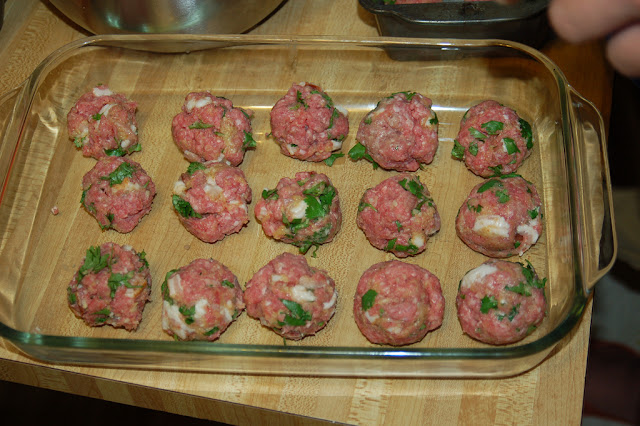Today is Saint Jean Baptiste day here in Quebec (Fête de la Saint-Jean-Baptiste), and is the biggest annual holiday celebration in the province. Coinciding with Midsummer, it was a huge festival in France from the 15th century onwards, and the traditions from that lovely country were brought over by settlers who began celebrating it here in the early 1600s. In honour of all things Quebecois, today's recipe honours a staple of our province's cuisine: les boulettes (meatballs).
Meatballs often make it to funeral buffet tables as they're bite-sized little protein bursts as well as delicious comfort foods; they fortify even as they satiate. The ones I've come across at family gatherings usually have a Swedish or Ukrainian lean, with lingonberry sauce served with the former and sour cream with the latter.
My variation on these delicious niblets differs from standard Quebecois fare, as I cannot warm up to the spices used in the traditional recipe: allspice, cinnamon, and cloves are the key spices used in tourtiere, creton, and the usual ragoût de boulettes (meat pie, pork pate, and meatball stew, respectively), but I can't wrap my head around using those spices for savoury dishes outside of Moroccan or Indian cuisine.
To me, they'll always be associated with mulled wine and gingerbread. If you'd like to use those spices to make it truly traditional, you can find an original recipe here. I've gone with French herbs and flavours instead, but do play around with seasonings to make it your own.
As an example, I like to add chopped olives or capers to mine, while others might mix in chopped bacon, shredded cheese, or even mushrooms.
Most of the meatball recipes I've come across use breadcrumbs or wheat flour as a binding agent, but this is an AIP paleo version using just a whisper of tapioca starch for that purpose.
I'm skipping a vegetarian/vegan version of this recipe because there aren't any meat substitutions for these that won't poison me (like seitan...), and as such I can't vouch for how they might turn out.
Ingredients:
- 1 lb ground beef, pork, turkey, or chicken
- 1/2 of a small Spanish onion, minced
- 2-3 garlic cloves, crushed or minced finely
- 1/2 cup of flat-leaf (Italian) parsley, chopped finely
- 1 teaspoon dried thyme, crumbled
- 1/2 teaspoon dried summer savoury, crumbled
- 1/2 teaspoon dried oregano, crumbled
- 1 teaspoon tapioca starch
Preparation:
Combine all of the ingredients well in a large mixing bowl, and refrigerate for an hour.
Preheat your oven to 400 degrees (or 375 if your oven runs hot). Measure out tablespoon-sized portions of the mixture and roll into meatballs, placing them on a parchment-lined baking sheet or greased glass baking dish as they're formed.
Bake for 25-30 minutes, or until they're no longer pink in the centre when you cut into them.
Traditional boulettes are served in a thick brown sauce, but if you're making a large batch of these for a memorial gathering, it's generally best to skip the gravy because someone will inevitably end up wearing it.
If you'd like to create a sauce of some kind that folks can spoon over the meatballs, persillade is a light, refreshing option made with fresh parsley and vinegar that's very easy to make, or you can also make tzatziki which, although not French, is rather gorgeous and one of my favourite dips:
Ingredients:
- 1 tablespoon olive oil
- 2 tablespoons lemon juice
- 2 garlic cloves, crushed
- 1 cup plain yogurt (coconut yogurt for AIP paleo, dairy or soy otherwise)
- 1 cup cucumber, peeled and either grated or minced
- 1 tablespoon fresh dill, chopped finely
- Sea salt
Preparation:
Combine all of the ingredients in a food processor, or just whisk them together in a mixing bowl. Season with salt to taste, and refrigerate for a couple of hours before serving. If you use coconut or soy yogurt, it can stay out at room temperature safely for hours.
















